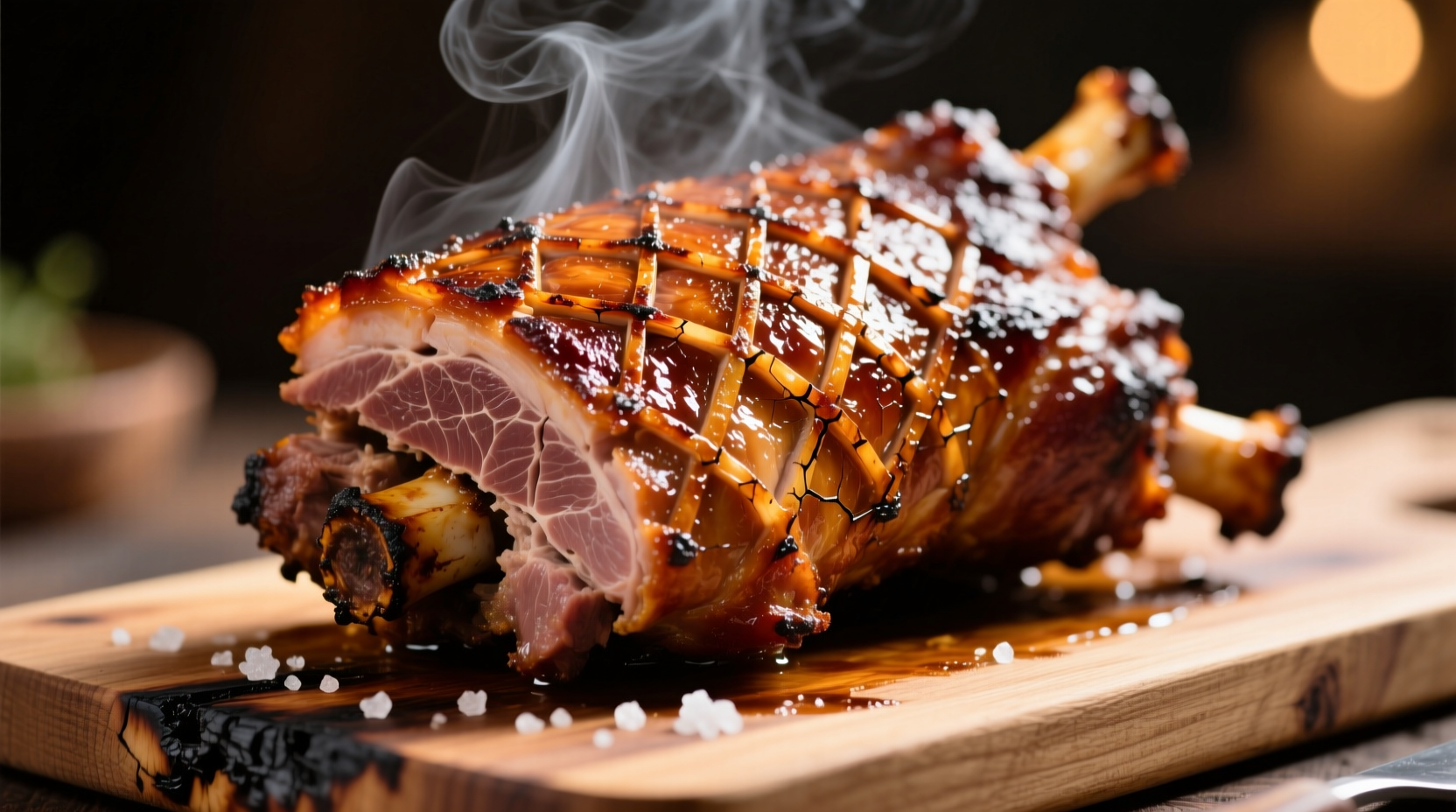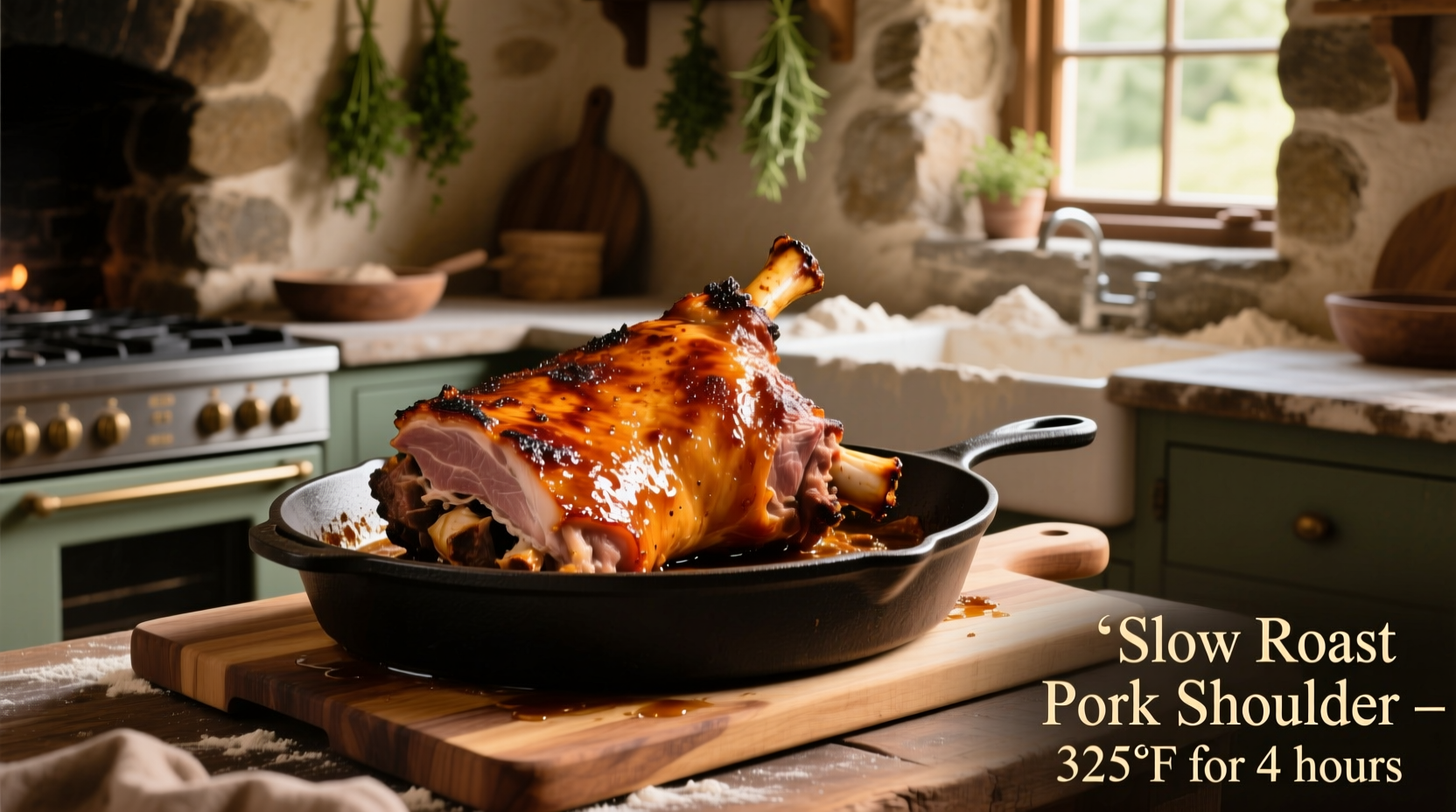Nothing beats the rich, succulent texture of perfectly cooked pork shoulder. This cut, also known as Boston butt or pork butt, contains abundant connective tissue that transforms into melt-in-your-mouth tenderness when cooked properly. The oven method delivers consistent, hands-off results without requiring specialized equipment. Whether you're planning pulled pork sandwiches for game day or an elegant dinner centerpiece, mastering oven-roasted pork shoulder opens up endless culinary possibilities.
Why Oven-Roasting Works Best for Pork Shoulder
Pork shoulder's high collagen content makes it ideal for slow cooking. Unlike leaner cuts that dry out in the oven, this fatty, marbled cut becomes incredibly tender through the slow breakdown of connective tissues. The oven provides precise temperature control that ensures even cooking without the guesswork of grill or smoker methods. You'll achieve that perfect balance of crispy exterior and fork-tender interior that defines exceptional pork shoulder.
Essential Preparation Steps
Proper preparation sets the foundation for success. Start with a 6-8 pound bone-in pork shoulder—the bone enhances flavor and helps maintain moisture during cooking. Trim excess external fat to about ¼ inch thickness, leaving enough to baste the meat as it cooks. For optimal flavor penetration, apply a dry brine 12-24 hours before cooking: generously coat all surfaces with salt (about 1 tablespoon per 5 pounds of meat) and refrigerate uncovered.
Seasoning for Maximum Flavor
While simple salt and pepper works beautifully, a well-crafted rub enhances the natural pork flavors. Combine these ingredients for a classic seasoning blend:
- 2 tablespoons coarse kosher salt
- 1 tablespoon freshly ground black pepper
- 1 tablespoon smoked paprika
- 2 teaspoons garlic powder
- 2 teaspoons onion powder
- 1 teaspoon cumin
- 1 teaspoon brown sugar
Apply the rub generously to all surfaces of the pork shoulder, pressing it gently into the meat. Let it sit at room temperature for 45-60 minutes before placing it in the oven—this ensures more even cooking.
| Oven Temperature | Cooking Time per Pound | Target Internal Temperature | Texture Result |
|---|---|---|---|
| 225°F (107°C) | 2 hours | 195-205°F (90-96°C) | Fall-apart tender |
| 275°F (135°C) | 1.5 hours | 195-205°F (90-96°C) | Perfect for pulling |
| 325°F (163°C) | 1 hour | 190-195°F (88-90°C) | Firm but tender slices |
The Cooking Process: Step by Step
Place the seasoned pork shoulder fat-side up on a wire rack set inside a roasting pan. The elevated position allows heat to circulate evenly around the meat. Insert an oven-safe meat thermometer into the thickest part of the meat, avoiding bone or large fat pockets.
Roast at 275°F (135°C) until the internal temperature reaches 195-205°F (90-96°C). This temperature range ensures complete collagen breakdown, transforming tough connective tissue into gelatin. For a 7-pound shoulder, expect approximately 10-11 hours of cooking time. Resist the urge to open the oven frequently—each peek adds significant time to the cooking process.
During the final 30-60 minutes of cooking, you can increase the oven temperature to 425°F (218°C) to crisp the exterior. This creates a delicious bark while maintaining tender interior meat. Monitor closely to prevent burning.
Understanding the Science: Collagen Breakdown Timeline
The magic of pork shoulder happens through a precise biochemical process. As the meat cooks slowly:
- 140-160°F (60-71°C): Collagen begins to contract, initially making the meat seem tougher
- 160-180°F (71-82°C): Collagen converts to gelatin, but the process is incomplete
- 195-205°F (90-96°C): Complete collagen-to-gelatin transformation creates that signature pull-apart texture
This scientific understanding explains why pulling pork shoulder too early results in tough, stringy meat. The USDA confirms that pork is safe to eat at 145°F (63°C), but for shoulder cuts, higher temperatures are necessary to achieve the desired texture through complete collagen breakdown.
Resting: The Critical Final Step
Never skip resting! After removing the pork from the oven, tent loosely with foil and let it rest for 30-60 minutes. This crucial step allows:
- Redistribution of juices throughout the meat
- Completion of the carryover cooking process
- Easier handling when shredding or slicing
During resting, the internal temperature typically rises another 5-10 degrees, then stabilizes. This resting period makes the difference between juicy, succulent pork and dry, disappointing results.
Serving and Storage Tips
For pulled pork, use two forks to shred the meat, discarding any large fat pockets. Mix in some of the reserved cooking juices for added moisture and flavor. Serve on brioche buns with your favorite barbecue sauce, or use in tacos, nachos, or pasta dishes.
Store leftovers in an airtight container with some cooking juices for up to 4 days in the refrigerator. For longer storage, freeze portions for up to 3 months. When reheating, add a splash of broth or water to maintain moisture.
Troubleshooting Common Issues
Dry pork: Usually caused by insufficient fat retention or overcooking beyond 205°F. Next time, leave more fat cap or reduce cooking temperature.
Tough texture: Indicates incomplete collagen breakdown. Ensure internal temperature reaches at least 195°F and consider lower cooking temperature for longer duration.
Bland flavor: Apply rub more generously and consider extending dry brine time to 24 hours for deeper flavor penetration.

Advanced Techniques for Culinary Excellence
For restaurant-quality results, try these professional techniques:
- Reverse sear method: Cook low and slow first, then finish with high heat for exceptional crust formation
- Smoke infusion: Add wood chips to a foil packet in the bottom of your oven for subtle smoky flavor
- Vegetable bed: Place onions, carrots, and celery in the roasting pan beneath the pork to create natural gravy and prevent sticking
Remember that humidity affects cooking results. In dry climates, place a small oven-safe dish of water in the oven to maintain moisture. In humid environments, you might need slightly longer cooking times for proper exterior development.
Frequently Asked Questions
Can I cook pork shoulder from frozen?
While possible, cooking frozen pork shoulder extends cooking time significantly (about 50% longer) and risks uneven cooking. For best results, thaw completely in the refrigerator for 24-48 hours before cooking to ensure even heat distribution and proper texture development.
How do I know when pork shoulder is done without a thermometer?
While a thermometer is strongly recommended for food safety and precision, you can test doneness by inserting a fork. Properly cooked pork shoulder should offer almost no resistance when pierced and should shred easily with minimal pressure. However, this method is less reliable than using a thermometer, which should read 195-205°F for optimal texture.
Why does my pork shoulder have a rubbery texture?
Rubbery texture typically indicates incomplete collagen breakdown, meaning the meat hasn't reached the necessary internal temperature (195-205°F) for sufficient time. This often happens when cooking at too high a temperature for too short a duration. Return the pork to the oven and continue cooking until it reaches the proper temperature range, checking every 30 minutes.
Can I use a convection oven for cooking pork shoulder?
Yes, but reduce the temperature by 25°F from standard recommendations. Convection ovens circulate hot air, which cooks food faster and more evenly. For pork shoulder, set your convection oven to 250°F instead of 275°F and monitor internal temperature carefully, as cooking time may be reduced by 15-25%.
What's the difference between pork shoulder and pork butt?
Despite the confusing names, both cuts come from the shoulder area of the pig. Pork butt (also called Boston butt) comes from the upper shoulder near the neck, while pork shoulder (picnic shoulder) comes from the lower portion closer to the leg. Both contain similar fat content and connective tissue, making them equally suitable for slow cooking, though pork butt typically has slightly more marbling.











 浙公网安备
33010002000092号
浙公网安备
33010002000092号 浙B2-20120091-4
浙B2-20120091-4